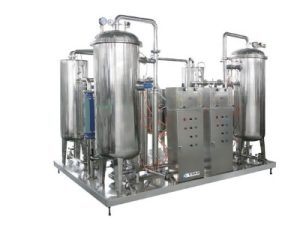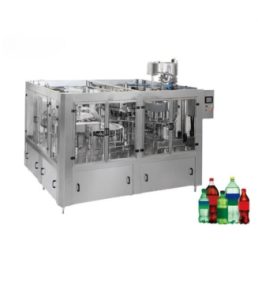1. Introduction
Carbonated beverages are a favorite among consumers worldwide. From sodas to sparkling water, their refreshing fizz is created through a precise manufacturing process. But how exactly do they get their bubbles? What role does a carbonated drink making machine play? This article explores the science behind carbonation and how carbonated filling machines ensure quality production.
2. The Science Behind Carbonated Beverages
At its core, a carbonated beverage is simply a liquid infused with carbon dioxide (CO2) under pressure. When you open a bottle or can of soda, you hear a distinct “hiss”—this is the release of CO2 gas. The sensation of fizzing and tingling on your tongue is a result of CO2 reacting with water to form carbonic acid, which creates the characteristic sharp taste.
Why Do Carbonated Beverages Have Bubbles?
Under pressure, CO2 dissolves in liquid and remains in a stable state. When the pressure is released, such as when opening a bottle, the CO2 escapes as bubbles, creating the effervescent effect. The amount of carbonation in a drink depends on factors like pressure, temperature, and the CO2 content.
Why Do Carbonated Drinks Taste Different?
The carbonic acid formed in the beverage gives it a slightly tangy taste, which enhances the overall flavor profile. Additionally, the type of sweeteners, flavoring agents, and other ingredients impact the final taste.
3. How Are Carbonated Beverages Made?
Carbonated beverages go through a systematic production process to ensure consistency in taste, carbonation level, and packaging quality. The key stages of production include:
A. Water Purification
The main ingredient in any carbonated beverage is water, which must be purified to remove contaminants. Reverse osmosis and filtration systems are commonly used to ensure clean, high-quality water.
B. Syrup Preparation
For flavored sodas, a concentrated syrup is prepared by mixing sweeteners, flavoring agents, and acids. This syrup is then blended with the purified water in precise ratios to maintain consistency.
C. Carbonation Process
At this stage, the beverage undergoes carbonation using a carbonated drink making machine. This machine injects CO2 into the liquid under controlled pressure, ensuring proper dissolution of gas. The carbonation process must be carefully monitored to maintain the right level of fizziness and taste stability.
4. The Role of Carbonated Drink Making Machines
A carbonated drink making machine is essential for ensuring uniform carbonation and production efficiency. These machines come in various types, including batch and continuous carbonation systems.
Key Features of a Carbonated Drink Making Machine:
- Precise CO2 Injection: Ensures optimal carbonation levels.
- Automated Mixing & Blending: Maintains consistent beverage composition.
- Pressure Control Mechanism: Prevents CO2 loss and maintains fizziness.
- Temperature Regulation: Keeps the beverage cool to enhance CO2 solubility.
Investing in an advanced carbonated drink making machine improves production efficiency while maintaining high-quality beverage standards.
5. Bottling and Packaging: The Role of a Carbonated Filling Machine
Once the beverage is carbonated, it needs to be bottled or canned using a carbonated filling machine. The filling process must be done with precision to prevent excessive foaming and CO2 loss.
How Does a Carbonated Filling Machine Work?
A carbonated filling machine operates using specialized techniques to maintain carbonation levels while ensuring high-speed, accurate filling. The main steps include:
- Bottle or Can Preparation: Containers are cleaned and sterilized before filling.
- Pressurized Filling: The beverage is dispensed into bottles or cans under controlled pressure to prevent excessive foaming.
- Sealing and Capping: The filled bottles or cans are immediately sealed to retain carbonation.
- Labeling and Packaging: Once sealed, the products go through labeling and packaging for distribution.
6. Conclusion
Carbonated beverages rely on precise technology, from CO2 infusion via a carbonated drink making machine to efficient bottling with a carbonated filling machine. Understanding this process helps manufacturers optimize production and deliver high-quality products. Investing in advanced equipment ensures efficiency, sustainability, and superior beverage quality.




